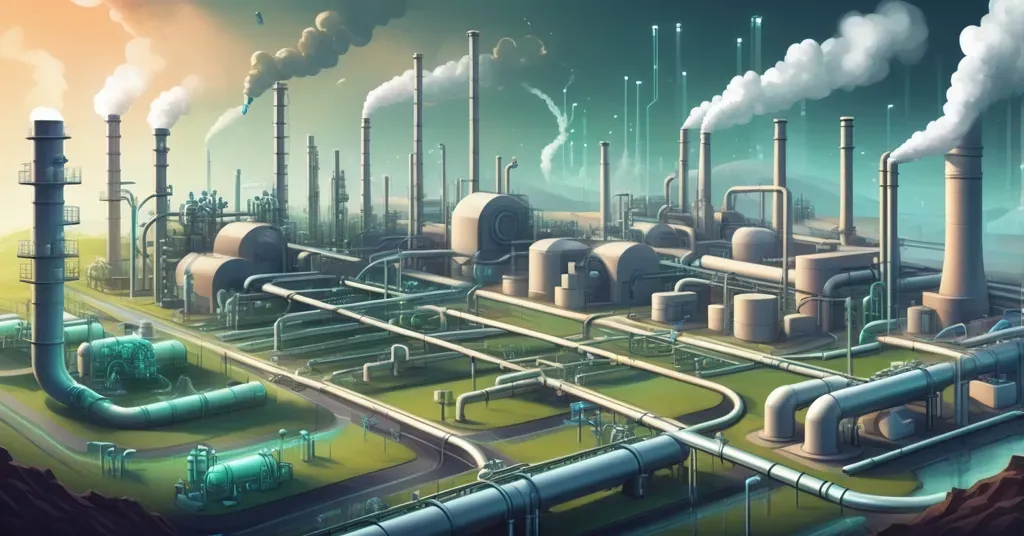
Top 10 Energy Shifts in 2025: AI, Nuclear, and Sustainability
AI's soaring energy demand drives a nuclear power revival, with tech giants investing in reactors. BP shifts focus to oil and gas, while green hydrogen and waste heat projects advance sustainability.
As AI's appetite for electricity reshapes the energy landscape, February 2025 marks a pivotal moment with a flurry of breakthroughs and strategic shifts. From a resurgence in nuclear power to innovative projects harnessing green hydrogen and waste heat, the energy sector stands at a crossroads. Yet, challenges persist, with major players like BP scaling back on renewable commitments and the EU grappling with clean energy competitiveness. Let's explore the top 10 developments shaping our energy future.
The AI Energy Surge
The rapid expansion of artificial intelligence (AI) has triggered an unprecedented rise in electricity demand. AI technologies, such as those used in data centers, require significant power to operate, pushing energy policymakers to reconsider nuclear power as a stable and scalable solution. U.S. Energy Secretary Chris Wright has likened the AI revolution to the Manhattan Project, highlighting the urgency of the situation.
"The rapid expansion of artificial intelligence (AI) has triggered an unprecedented rise in electricity demand, forcing energy policymakers to reconsider nuclear power as a stable and scalable solution." — U.S. Energy Secretary Chris Wright
Tech giants are responding with significant investments in nuclear power. Microsoft has agreed to restart the Three Mile Island plant, while Google and Amazon are exploring small modular reactors (SMRs). These reactors are smaller, more manageable nuclear reactors that can be deployed in various locations, offering a potential solution to meet growing energy needs.
Nuclear Power's Comeback
NRG Energy, GE Vernova, and Kiewit Corp. are set to construct four natural gas-fired power plants, aiming to supply approximately 5 gigawatts of electricity. This move is part of a broader effort to support AI's growing energy demands, illustrating the sector's adaptability to emerging challenges.
In a groundbreaking move, Proxima Fusion has released open-source plans for a commercial nuclear fusion reactor, targeting a pilot plant by 2031. Fusion energy, likened to the sun's energy, combines atoms to release a massive amount of energy in a controlled way on Earth. This collaboration with the Max Planck Institute for Plasma Physics and other institutions signifies a significant step towards making fusion energy a reality, potentially revolutionizing our energy landscape.
Strategic Shifts in the Industry
BP's decision to increase its oil and gas production target to 2.4 million barrels per day by 2030 reflects a strategic shift driven by slower-than-expected global adoption of renewables and the need for financial sustainability. The company cites these pressures as reasons for stepping back from its earlier renewable commitments, a move that raises questions about the balance between traditional and renewable energy sources.
"The company cites slower-than-expected global adoption of renewables and the need for financial sustainability." — BP on shifting focus to oil and gas
Innovative Sustainability Projects
Innovative projects are pushing the boundaries of sustainability. The University of Wollongong has developed a green hydrogen electrolyser with 95% efficiency, a breakthrough that could transform hydrogen production. This efficiency level is significant, far surpassing current standards and making green hydrogen more viable for widespread use.
Similarly, British Gas is piloting a program to utilize waste heat from data centers to provide free hot water, potentially saving households up to £350 annually. These initiatives highlight the creative ways in which the sector is addressing energy efficiency and sustainability.
Transforming waste into energy, a closed landfill in Buffalo, NY, is being converted into a solar power hub by SolarBank and Viridi. This project exemplifies the potential for innovative uses of existing infrastructure to contribute to renewable energy goals.
Australia is exploring the production of sustainable aviation fuel from sugarcane waste, funded by the Australian Renewable Energy Agency (ARENA). This initiative underscores the global push towards reducing carbon emissions across various sectors, including aviation.
Challenges in Clean Energy Competitiveness
The EU faces challenges in maintaining clean energy technology competitiveness, with high energy prices and supply chain issues hampering progress. A report from the European Commission highlights these struggles, emphasizing the need for strategic interventions to boost clean energy initiatives.
Expanding Battery Storage Capacity
Finally, the U.S. is projected to add a record 18.2 gigawatts of battery storage capacity in 2025, according to the U.S. Energy Information Administration (EIA). This expansion is crucial for integrating renewable energy into the grid and ensuring energy reliability. A gigawatt is enough power to supply electricity to around 750,000 homes, highlighting the scale of this development.
Key Takeaways and Questions
- How can the energy sector balance the increased demand from AI with sustainable energy goals?
This balance can be achieved by investing in a mix of energy sources, including nuclear power for stability, and ramping up renewable energy capacity with enhanced storage solutions to ensure sustainability.
- What are the potential long-term implications of BP's decision to focus more on oil and gas rather than renewable energy?
BP's shift may slow the global transition to renewables, potentially extending reliance on fossil fuels and impacting climate goals, though it could provide short-term financial stability for the company.
- How might the open-source approach to nuclear fusion technology impact the global energy landscape?
Open-source fusion technology could accelerate global innovation and adoption, potentially leading to a more decentralized and accessible energy future, though it may also face challenges in funding and scalability.
- What challenges might arise in scaling up innovative projects like green hydrogen production and repurposing waste heat?
Scaling these projects may encounter challenges such as high initial costs, technological limitations, and the need for supportive infrastructure and policies to make them economically viable on a larger scale.
ExO in Action: Real-World Examples
Companies like Microsoft and Google are leveraging Exponential Organization (ExO) principles to drive innovation in the energy sector. By embracing abundance thinking and exploring new technologies, these organizations are at the forefront of addressing AI's energy demands. For instance, Microsoft's investment in nuclear power reflects a strategic approach to scaling energy solutions, aligning with ExO's focus on transformative growth.
Looking Ahead: Preparing for the Energy Landscape of 2030
As we look to the future, it's clear that the energy sector will continue to evolve rapidly. Organizations must prepare by staying informed about emerging technologies and trends, such as the potential of in-memory and 3D stacked computing to reduce AI's power consumption. Embracing ExO methodologies can help businesses navigate these changes and drive exponential growth in sustainable energy solutions.
The energy sector's journey in February 2025 is a testament to the complex interplay of technological innovation, strategic shifts, and sustainability challenges. As we move forward, balancing these dynamics will be key to shaping a sustainable energy future.
For those eager to stay updated on the latest in energy technology and industry news, be sure to check out our daily Energy technology / industry news feed.
Final Thoughts
Explore these concepts further and consider how you can apply Exponential Organization principles to your energy strategies. Embrace the power of exponential technologies and the transformative strategies outlined in "Exponential Organizations 2.0" to drive innovation and achieve 10x growth in the energy sector.
- Leverage exponential technologies like AI to optimize energy use and production.
- Explore the potential of nuclear and fusion energy as stable, scalable solutions to meet growing demands.
- Invest in innovative projects like green hydrogen and waste heat utilization to enhance sustainability.
- Stay informed and adapt to the evolving energy landscape to ensure a sustainable future.
ExO Insight Newsletter
Join the newsletter to receive the latest updates in your inbox.









